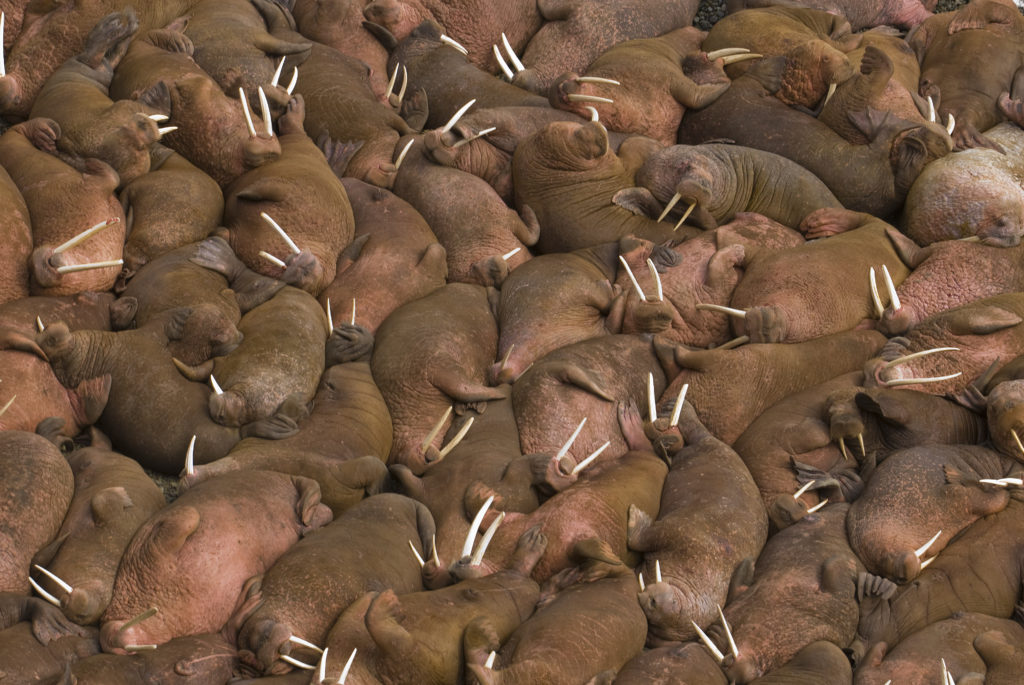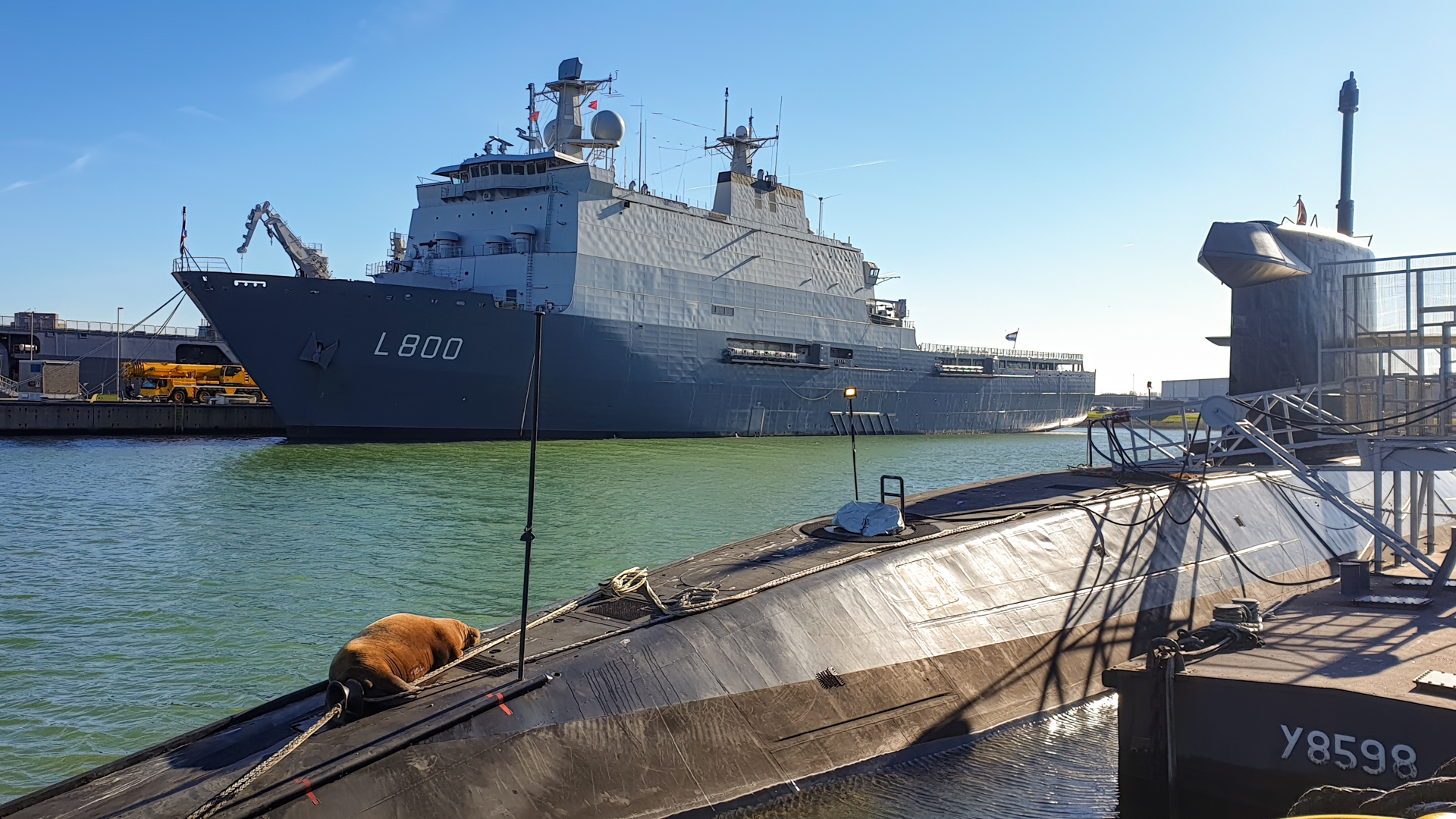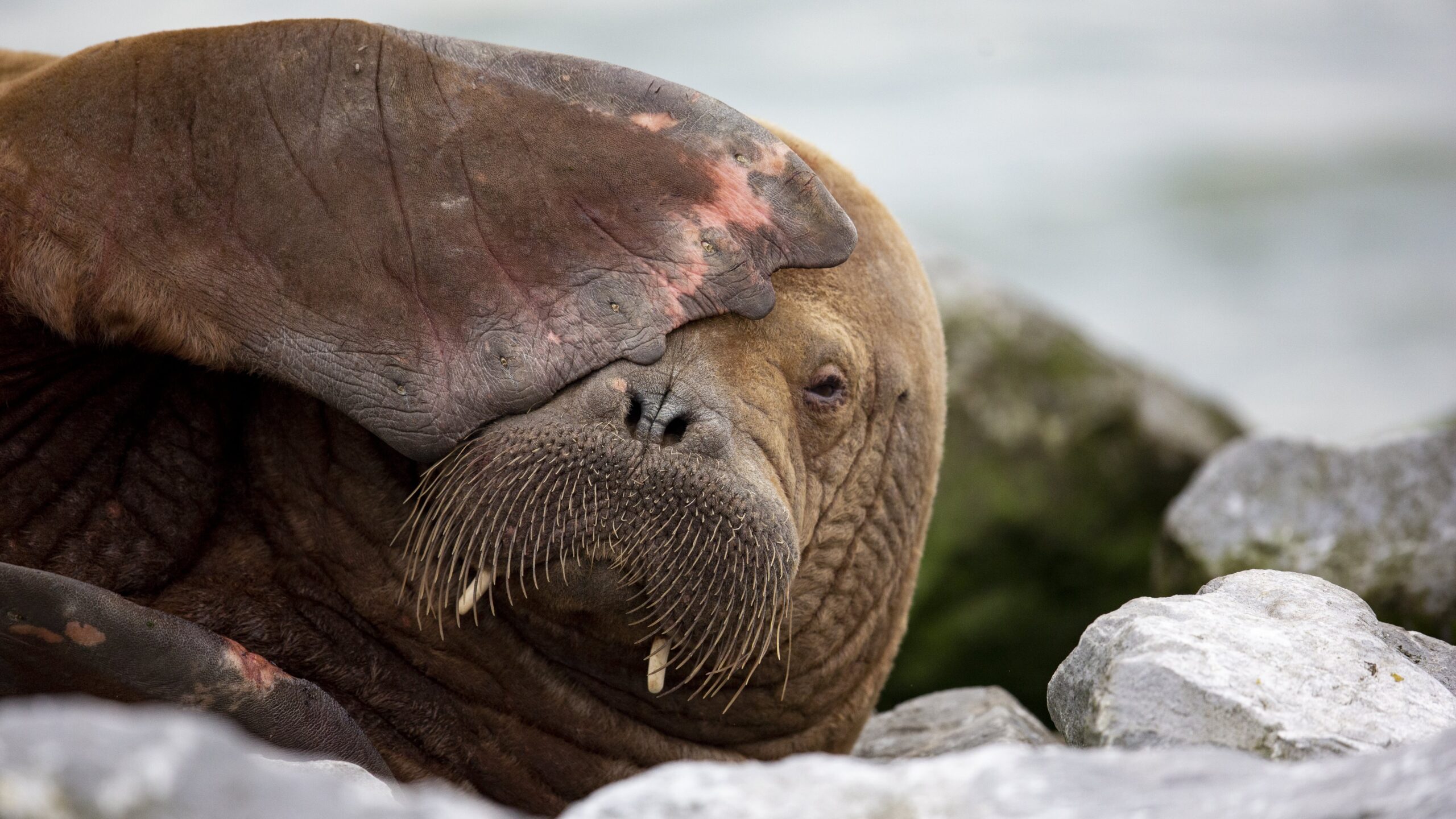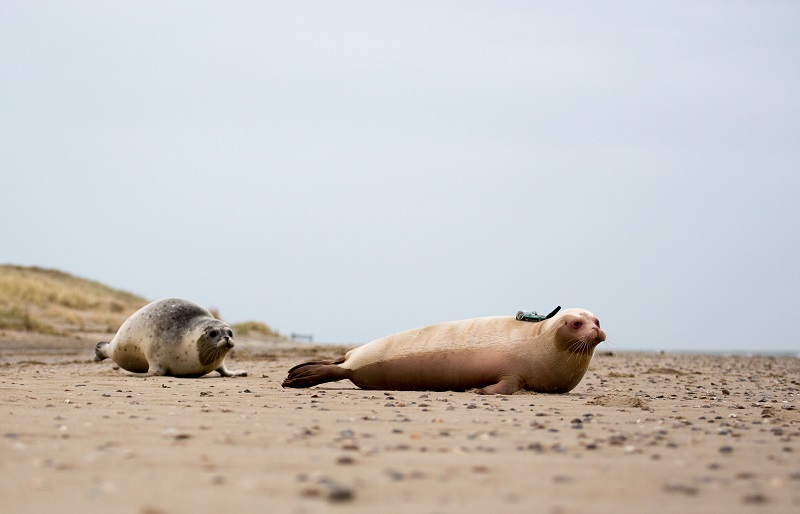The North Pole is warming up faster than anywhere else in the world. Because the ice is melting, dozens of seals and walruses are losing their familiar habitats. Where are they going? That is what Sophie Brasseur and Geert Aarts are studying.
The submarine Zr. Ms. Dolfijn was anchored in Den Helder in October 2021 when the captain got an unusual phone call. It was Sophie Brasseur of Wageningen Marine Research. A walrus had just picked the submarine as its new ‘haulout’, or resting place, and might excrete on it. If the walrus did so, the marine biologist kindly requested the captain to collect the droppings and send them to her. The seafarer was amused, and agreed to collaborate.
It’s a rare event for a walrus to turn up in the Netherlands. In 2021, Freya was the first walrus to arrive on these shores in 23 years. A second walrus came the next year, and this spring a hooded seal – a species from the North Pole – gave birth on the beach on the island of Vlieland. This could be coincidental, or it could suggest the start of a trend. The polar ice in the Arctic, where many seals and walruses go to rest, is disappearing due to climate change. In search of new habitats, the animals can end up here. The question is whether they will stay.
The walrus might cope better with warmth than we think
The Arctic region is warming up at least twice as fast as the rest of the world. All the ice in the Arctic Ocean is expected to disappear between 2030 and 2050, according to the IPCC’s latest climate report. And that ice is precisely where millions of seals and tens of thousands of walruses find places to rest, breed and give birth to their young. If they disappear or move away, that could have a big impact on both their old and their new habitats: after all, they are large predators and devour all sorts of fish, shellfish and lobsters. Walruses, for example, need to eat 80 kilos of molluscs a day, says Brasseur.
Squashed
‘Freya the walrus probably came from the nearest population on the islands of Spitsbergen and the nearby Franz Josef Land archipelago,’ says Brasseur. ‘That population has grown since hunting stopped in the mid-20th century.’ Their numbers grew from a few hundred to the more than 5000 animals living there now. In the summer most of the males live on Spitsbergen, and the females and young on Franz Josef Land. In the winter, the animals move onto the pack ice to mate and give birth. Walruses need to stay close to shallow waters where they can eat shellfish. The Arctic Ocean gets deeper further north, and they can’t find food there. So it is not an option for them to follow the sea ice.
Instead, walruses are increasingly looking for land, says Geert Aarts, another marine biologist and a colleague of Brasseur’s. ‘Many walruses stick together on small islands. They lie so close together that some of them get squashed.’ With more and more walruses, and fewer and fewer haulouts, Brasseur is not surprised that the animals are turning up in the North Sea in search of new, less crowded spots.
A year in the North Sea
Even though the North Sea is quite a bit further south, it appears to be a suitable habitat for the walrus. Freya proved that, according to Brasseur. ‘Some of the water she swam here in water was at nearly 20 degrees. It might be that the walrus can cope with warmth better than we think.’ It may help that walruses don’t have a thick hide like seals.
The walrus sucks the flesh out of the shells and blows the rest away; so in the droppings you mainly find soft tissue
And Freya the walrus also found enough to eat in the North Sea, as the analysis of her poop showed. As well as the droppings from Den Helder, Brassuer managed to get hold of some found on the island of Terschelling. Normally she searches the specimen for bones and bits of shell, to determine the animal’s diet, but that’s not possible in the case of walruses. ‘Walruses suck the flesh out of the shells and blow the rest away. So you mainly find the soft tissues in the poop.’ So Brasseur uses DNA techniques to identify the species of the prey.
Hooded seal
‘The surprising thing was that there was one dominant species in the diet: the Atlantic jackknife clam,’ says Brasseur. Heaps of shells of this exotic shellfish are found on Dutch beaches. So there is food enough, and Freya ended up swimming around the North Sea for a year. In August 2022 the Norwegian government shot her dead in Oslo harbour: she posed a danger to onlookers who came too close to her.
So the walrus might find a new home in the North Sea, but Brasseur is not so sure about the hooded seal, a large, spotted species. The males of the species unfold and inflate a nostril during the mating season, creating a red ‘hood’ to show off with. ‘The hooded seal is used to giving birth on ice floes at sea. That is a very mobile and unpredictable system, so the nursing period is extremely short: four days after birth, the pup has doubled its weight and the mother abandons it. I’m not sure the Vlieland sandbank would be a good alternative for such animals: in the Arctic you rarely see them on land.’
In spite of a ban on commercial hunting in 2007, hooded seal numbers are going down. The nearest population east of Greenland went down by 90 per cent in 50 years. Their continued decline in numbers is probably because the sea ice is shrinking and the seal nurseries are getting closer to land, making it easier for polar bears to seize the pups.

Out of options
As the sea warms up even more, Aarts expects that the hooded seal will move further north. The biologist wants to use a computer model to predict the behaviour of seals in a warmer climate. ‘Most seal species are found around the polar regions. The theory is that they are faster in cold water than the fish they prey on.’ Fish are cold-blooded and are therefore slower in the cold than the warm-blooded seal. ‘In warmer water, fish outswim the seals. By moving further north, seals retain their advantage over their prey.’
‘But there are limits to how far they can move, of course,’ adds Aarts. If the warming continues, the habitat of the hooded seal – on the edge of the sea ice – will shrink further. ‘I expect that animals will get lost more often and end up on our coast.’ Brasseur doubts whether seals can move further north anyway. ‘Besides warming, their movements depend on what humans do at sea. If the North Pole becomes navigable, there will be more ships, oil rigs and fisheries. And that will chase the seals away.’
All in all, the times are changing for walruses and seals. But whereas the walrus seems to have the option of heading for warmer climes, it is not certain that the northern seal species like the hooded seal can do that. Nothing more has been seen of the mother and pup on Vlieland this spring. If we do see more hooded seals here, it would mean they can’t find anywhere else to settle. And that’s not a good sign.
Counting seals from space
Before climate change, researchers had a fairly accurate idea of the seal populations in the Arctic Ocean. The Norwegians do an annual count from an aeroplane of the hooded seals and harp seals on the ice floes. Now that the ice is melting and the seals might move off to other places, the search area is too big to scan by plane.
Reason for Jeroen Hoekendijk, who is doing his PhD with Brasseur and Aarts, to develop software that can count seals on satellite images. ‘A seal looks like a dark grain of rice on a light background. You don’t see enough detail to identify a species.’ Instead, Hoekendijk gets the software to look at the way they lie. That worked for aerial photos of the Wadden Sea: ‘The computer can distinguish between the grey and the common seals on our sandbanks because the grey seals lie closer together than the common seals. We hope the software can differentiate between the seal species on satellite photos of the Arctic as well using such differences in social distancing.’

 A walrus chose the submarine Zr. Ms. Dolfijn in Den Helder as a place to rest (2021). Photo Jeroen Hoekendijk
A walrus chose the submarine Zr. Ms. Dolfijn in Den Helder as a place to rest (2021). Photo Jeroen Hoekendijk 

